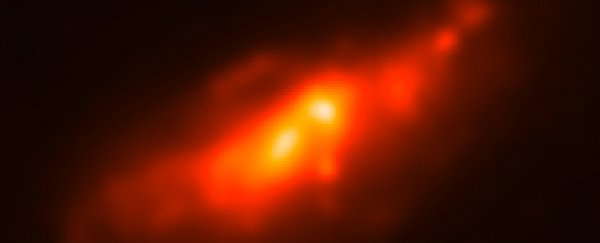Wrapped up within the nearby Cocoon Galaxy, astronomers have detected a rare double heart. Recognised in the Northern Hemisphere for its distinct shape, this distorted spiral galaxy, otherwise known as NGC 4490, appears to be hiding a true rarity.
Despite its relatively small size - its system is roughly a fifth of the Milky Way - this cocoon holds not one, but two central cores.
"I saw the double nucleus about seven years ago," says astronomer Allen Lawrence, who began the research at University of Wisconsin-Madison before moving to Iowa State University.
"It had never been observed - or nobody had ever done anything with it before."
Seeing both nuclei at the same time is tricky. The first can only be made out using optical telescopes, while the other, which is obscured by dust, can only be detected using radio and infrared telescopes.
In 2013, while studying astronomy at the University of Wisconsin-Madison, Lawrence decided to study NGC 4490. Although scientists had observed one nucleus with optical telescopes, and seen another with radio telescopes, no one had compared notes and discovered that there was two nuclei in the galaxy.
 (Lawrence et al., arXiv, 2020)
(Lawrence et al., arXiv, 2020)
Because both nuclei show roughly the same size, mass and luminosity, Lawrence and his colleagues suspect the Cocoon Galaxy is in the late stages of a much-earlier collision between two galaxies.
Today, NGC 4490 has already moved on and is now in the process of interacting with another, NGC 4485. This previous history of merging, however, might help explain why the Cocoon Galaxy is shrouded in an extended hydrogen plume.
"The feature is particularly intriguing as a double nucleus morphology is not a common structure seen in low redshift spiral galaxies," the authors explain.
"For example, the Spitzer Infrared Nearby Galaxy Survey (SINGS) legacy project examined a sample of 75 nearby galaxies representing the full range of Hubble types. While this is not a complete survey, it is interesting to note that none of the spiral galaxies observed as part of SINGS show a double-nucleus morphology in the near and mid infrared like we see in NGC 4490."
In 2004, the Catalog of Double Nucleus Disk Galaxies included only 107 objects, and the Seyfert galaxy Markarian 315 is one of these rarities. Like the Cocoon Galaxy, this spiral object also contains two nuclei, roughly 6,000 light-years apart, and probably powered by massive black holes accreting matter.
In fact, one reason astronomers get so excited by double nuclei is that they might be one way of driving gas deep into the heart of a galaxy to fuel a massive black hole.
"This project demonstrates that using multiple wavelengths from space- and ground-based observations together can really help us understand a particular object," says astrophysicist Charles Kerton.
The study pre-print is available on arXiv and has been accepted for publication in The Astrophysical Journal.
